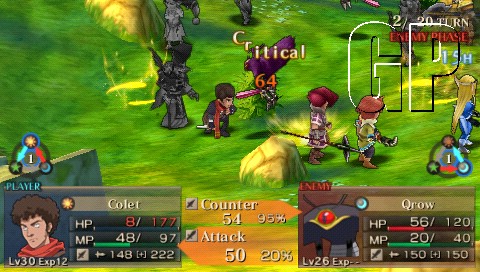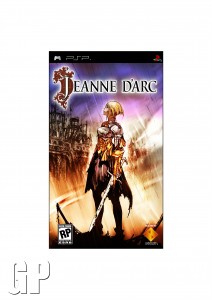
I often praise the PSP as a mecca for turn-based tactical RPGs – Disgaea! Final Fantasy Tactics! Tactics Ogre! – and over the past few months, I’ve pencilled another name onto that list: Jeanne d’Arc, a 2007 title from Level 5 (very!) loosely inspired by the historical Saint Joan. It starts off rather generically, but now that I’m close to the end, I’m glad I gave it a second chance.
By way of introduction, Jeanne plays out like a cross between Fire Emblem and Final Fantasy Tactics. You command a squad of characters, each of whom belongs to a set class and has his or her own strengths and weaknesses. Notably, characters cannot permanently die! Between missions, you assign equipment and special skills (the two work a bit alike; a finite number of skills are available at any one time, and you acquire new skills via crafting and enemy drops). Some skills are class-specific, while others can be assigned at will. For example, Jeanne and her friend Liane both wield swords, so they have access to the same pool of class-specific skills. However, Liane trades off durability in exchange for stronger magic, suggesting players should assign melee boosters to Jeanne and magic spells to Liane. Combat plays out similarly to other tactical RPGs: park sturdier sorts at the front and mages/archers at the back, advance methodically, and heal as needed. So long as the party is adequately levelled, the game is reasonably easy, and since it’s also not very grindy, that’s not a hard condition to meet.
Jeanne’s appeal stems largely from how it gets the basics right.. The levels are creative, both in their layout (the maps are a nice mix of wide, narrow, flat, and steep) and in their objectives: most are simple sweeps, but some require you to make it to an escape point, or defend a key location. One, notably, is an imaginative riff on a certain infamous boss battle from FFT. The pacing is just right: combatants hit hard enough to keep the pace brisk, but (a single annoying escort mission aside) not so hard that the game turns into an exercise in luck-driven one-hit KOs. And while it’s easy in the sense that I’ve rarely seen the game over screen, that doesn’t mean it’s boring: I still reach for the grey matter in every battle.
This by itself would be enough to make me recommend Jeanne to genre fans in need of a fix, but on top of that, Jeanne adds several interesting little gameplay mechanics. While they aren’t hugely significant, they do keep the game feeling fresh. One is positioning: keeping characters next to each other gives them a defensive bonus, and the bigger the clump, the bigger the bonus. Striking an enemy will “power up” the tile on the victim’s other side (visible in the above screenshot – note the glowy yellow rings at the upper left and at the far right), but someone standing on the powered-up tile might be away from the group and hence vulnerable. (One tactic I like: run a hard-to-hit character, say the nimble thief Colet, around the back of the enemy line to power up a tile on the front. My slow-moving characters approach the front in a clump, and one stands on the powered-up tile; Colet, meanwhile, can happily look after himself.)
The game’s signature mechanic, however, is that Jeanne and several of her allies wear magic armlets that let them temporarily transform into super-soldiers – and if they kill an enemy while transformed, they get another turn. If they score another kill, they get another turn. And another. And another. The video below (starting at about 1:15) shows this in action:
http://www.youtube.com/watch?feature=player_detailpage&v=BeY4GpXk_Q0#t=75s
This has a couple of implications. It changes the ideal tactics: while most games encourage players to focus fire so as to completely eliminate enemies and reduce incoming damage, in Jeanne it’s often preferable to bring a whole host of enemies down to low health (leaving them vulnerable to a single transformation rampage) instead. As with positioning, this isn’t a revolutionary feature in and of itself, but it is a nice point of differentiation relative to Jeanne’s peers.
More importantly, it helps give Jeanne a particular kind of fun. The joy of strategy games lies in reading the situation, crafting a plan, and finally seeing it come together (and generally, the deeper the game, the more profound the delight – anyone who’s played Dominions 3 will know what I mean). The drawback is that it can take a lot of time and effort for that plan to pay off! Puzzle games compress that into a single “aha!” moment and are quicker to play, but typically just have One True Solution. The transformation mechanic gives Jeanne a bit of the best of both worlds. Working out how to bring down a mass of enemies down to low health, then actually doing so, is quick and relatively simple – far simpler than orchestrating victory in Civilization or Dominions! But the basic skills – analysis of a fluid situation, thinking ahead, allocation of scarce resources – are the same. And the moment of triumph, when Jeanne carves her way through four or five enemies in one round, is real.
That, in fact, is almost a metaphor for the gameplay as a whole. By genre standards, Jeanne is relatively short (I’m at 38 hours and could probably finish before 40), simple, and easy. But that doesn’t make it mindless – either on the developers’ part, or on the player’s – or boring. Jeanne’s designers clearly put love and thought into their work, and it shows. This is one title genre fans should check out.
